Closest Asteroid Flyby in 2022 Was Really Space Junk From NASA Mission
It's getting harder to tell the space rocks from the space garbage.

What first looked like a wayward asteroid turned out to be a spent rocket booster.
Sometimes it's hard to know exactly what you're seeing when tracking something hundreds of miles over your head moving at speeds of several meters per second.
For about a day, astronomers thought they'd caught an asteroid making the second closest observed pass by Earth on record. But the object formerly known as asteroid 2022 UQ1 has now been properly identified as a booster that helped launch NASA's Lucy spacecraft on Oct. 16, 2021.
So not a space rock, but a piece of space junk that has been floating around in space for over a year.
It turns out that 2022 UQ1 is actually the #LucyMission Centaur. It was suspicious that it passed Earth exactly 1 year ago, on the date of Lucy's launch, and then again on Sunday when Lucy made its Earth flyby for a gravitational assist. pic.twitter.com/Bh2mDTC6Ea
— Tony Dunn (@tony873004) October 19, 2022
The object was first spotted by the Asteroid Terrestrial-impact Last Alert System (ATLAS) telescope in Chile on Tuesday, then captured by a handful of other observatories.
"Follow-up from three other sites confirmed its NEO-like orbit and its close approach to Earth on Oct. 16 within a few hundred km above Earth's surface," reads a notice from the Minor Planet Center at Harvard University.
A flyby that close means the object would be passing through low-Earth orbit, which is populated by thousands of satellites (mostly Starlink) and one group of humans on the International Space Station. It also seemed unusually large for an asteroid passing that close by that had never been previously noticed.
In NASA's database of the closest asteroid approaches observed, the top 40 are estimated at less than 50 feet (15 meters) across, but 2022 UQ1 looked to be as much as double that width.
Then, when NASA engineer Davide Farnocchia and veteran amateur astronomer Bill Gray took a closer look at the object, they discovered it's orbit matched that of the booster from the Lucy mission -- NASA's endeavor to study the primitive Trojan asteroids traveling alongside Jupiter.
So, asteroid 2022 UQ1 is no more -- it has now been deleted from the official catalog of near-Earth objects.
But that does little to quell humanity's rising anxiety about the ever-growing cloud of space junk above our heads and its potential impacts (literally) on our satellite-dependent society and astronauts in orbit.

